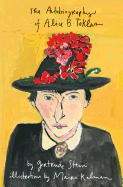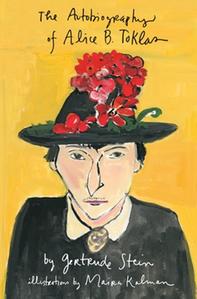
 With a text first published in 1933, this illustrated version of Gertrude Stein's The Autobiography of Alice B. Toklas transports readers to early 20th-century Paris and the birth of modernism in painting and literature. Artist Maira Kalman's (And the Pursuit of Happiness) lustrous images bring this classic to life. Kalman is a renowned fine artist who has illustrated other classic works, notably William Strunk and E.B. White's The Elements of Style. Here she captures the intricacies and material culture of Parisian salon life.
With a text first published in 1933, this illustrated version of Gertrude Stein's The Autobiography of Alice B. Toklas transports readers to early 20th-century Paris and the birth of modernism in painting and literature. Artist Maira Kalman's (And the Pursuit of Happiness) lustrous images bring this classic to life. Kalman is a renowned fine artist who has illustrated other classic works, notably William Strunk and E.B. White's The Elements of Style. Here she captures the intricacies and material culture of Parisian salon life.
Stein authored the "autobiography" of her life partner, Toklas, by imitating her plainspoken, matter-of-fact voice. Actually a biography of Toklas and autobiography of Stein herself, the book focuses on the couple's time living in Paris before and after World War I. It was a magical time of modern innovation in technology and the arts. The book describes the women's relationships with leading intellectuals, writers and artists such as William James, Pablo Picasso and Ernest Hemingway, among myriad others. The famed scene of Paris at the time gave birth to cubism in painting and modernism in literature, and the book provides a front-seat view of artists, many before they were famous, leading a life of the mind and pushing the boundaries of media. Brought into focus are not only works of art, but eccentric personalities, squabbles and human foibles. Nonetheless, a sense of affection permeates these pages, perhaps best exemplified by the long, abiding relationship between Stein and Picasso.
Rendered in broad, colorful strokes--themselves reminiscent of the artistic period--Kalman's portraits of now-famous artists and writers are lively and evocative, including Picasso and his partner Fernande, the Matisses and the Cézannes, Hemingway, William James and, of course, Stein and Toklas, among many others. Some portray Stein's famous home, the salon, the kitchen, all quaint yet lush interiors, while others capture the greater neighborhood, city and even countryside. The pictures are captioned with Stein's handwritten words, adding a certain charm and glamour to the story.
Though written in a plain style, the book offers sophisticated takes on the formation of modern art and the "heroic age of cubism." It bristles with intellectual energy and keen art criticism. "His portraits had the aridity but none of the elegance of David," Stein, the actual narrator, comments on a painter. Her critiques follow the evolution of cubism and the surrealism that followed. (Not all the takes are good. Stein's reductive comments on "negro" art would be considered insulting and problematic today.) Not only is painting analyzed by the narrator, but the art of writing as well. Stein describes many conversations with other writers, like the young Hemingway, about form and the craft of writing. Some of the best moments in the book are about Stein's particular writing process. "She was much influenced by the sound of the streets and the movement of the automobiles," the narrator says of Stein. "She also liked then to set a sentence for herself as a sort of tuning fork and metronome and then write to that time and tune."
The Autobiography of Alice B. Toklas reads like a love letter to a bygone era, when human imagination still teemed with possibilities. This illustrated version will appeal to fans of art history and literature. It's a testament to writers and artists who changed the world. --Scott Neuffer, writer, poet, editor of trampset
Shelf Talker: Maira Kalman's beautifully illustrated version of Gertrude Stein's nonfiction book reminds readers of a vibrant bygone era.

